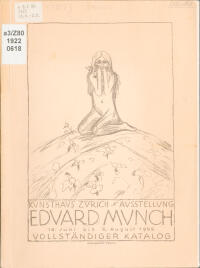Edvard Munch
18.06.1922 – 02.08.1922
Curated by Wilhelm Wartmann.
Location Kunsthaus.
Curated by Wilhelm Wartmann.
Location Kunsthaus.
Painter of Love, Illness and Death
Edvard Munch (b. 1863 Løten, d. 1944 Oslo) is known to a wide public, mainly for the haunting artwork The Scream (four paintings and one lithograph between 1893 and 1910). As with van Gogh, interest in his life often dominates over his art. This extremely productive Norwegian artist, through whose work love, illness, and death pass, is seen as an important representative of Symbolism and as a pathbreaker for Expressionism. “While he was alive, it seemed decided that he would become an almost mythical figure,” wrote Wilhelm Wartmann, the Kunsthaus Director, in his introduction.Wilhelm Wartmann was proud to provide the painter and graphic artist with his first solo exhibition since World War I. “The pictures live from their immediacy […] and from the effect of an aggressive energy that comes to us from his images,” he noted in the catalog to the exhibition. Seventy-five paintings were shown, but also an impressive number of works on paper – 150 lithographs, 125 etchings and 60 woodcuts – from a period of about 35 years. They included Puberty (version of 1894), Jealousy (1895), The Sick Girl (third version from 1907) and a street scene that seemed almost cheerful (Rue de Rivoli, 1891). Each individual picture, according to Wartmann, was related to his total oeuvre, which, however, could not yet be viewed in its entirety – when he died, Munch left about 1100 paintings and thousands of works on paper to the City of Oslo.
The exhibition had a wide reception and was enthusiastically celebrated everywhere. In the Tagesanzeiger it was noted that “the dark, pessimistic, neurotically passionate, and nervously agitated provided the basic tone of the exhibition” and yet the final assessment was positive: “In the case of Munch we are dealing with artist of the highest rank.” Paul Seippel described Munch as a painter of dark passions, whose “sensitivity and troubled thought […] make him an authentic interpreter of our restless times” (Journal de Genève).
With the exhibition appeared a catalog with 30 illustrations, an introductory essay by Wilhelm Wartmann and a list of works.
[Peter Stohler]
Further information
Wilhelm Wartmann was proud to provide the painter and graphic artist with his first solo exhibition since World War I. “The pictures live from their immediacy […] and from the effect of an aggressive energy that comes to us from his images,” he noted in the catalog to the exhibition.
45 days
1 Artist
1 Artist

1/2
exhibition catalog

2/2
exhibition poster
Image: Edvard Munch
Image: Edvard Munch
1/2